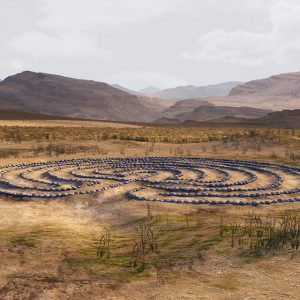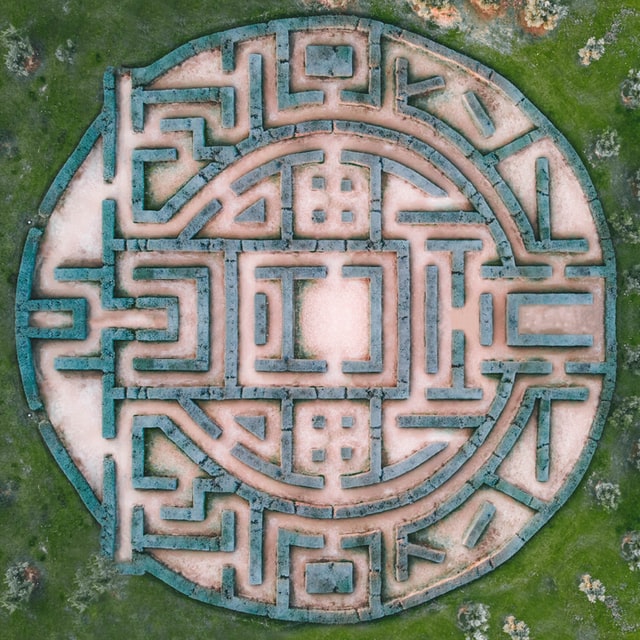SA writes: “I was told that the Catholic Church does not approve of the use of labryinths for prayer. Yet I see so many priests and nuns engaged in and teaching this type of practice. When I tell other Catholics this is not a Catholic practice, but New Age, they say it is nobody’s business how they choose to pray. I have found confusing data regarding this matter. Would you please enlighten me?”
The modern labyrinth movement is a troubling New Age trend that is introducing people to a non-Christian belief system that has no place in a Catholic setting.
For those who don’t know, a labyrinth is a circular maze with eleven concentric circles and a single path which makes 28 loops – seven in each of the four quadrants of the circle. People walk the path as a spiritual device to meditate, relax, or “find their soul assignments” as New Agers like to say.
The origin of the labyrinth comes from King Minos of Greek mythology who created the first maze as a prison for a wayward minotaur. It has been used ever since as a religious symbol and spiritual tool by a variety of pagan cultures such as the Mayans, Celts, and Native Americans.
The first “Christian” labyrinth appeared in a fourth-century Basilica in Orleansville, Algeria, which contained the words “Sancta Eclesia,” indicating its use for religious purposes. The most famous example can be found at the Cathedral of Chartres in France, which was constructed in the thirteenth century and allegedly used by Christians as a substitute for going on pilgrimage to Jerusalem during the Crusades.
However, the labyrinths in use today are not even remotely associated with these Christian labyrinths. Today’s version was popularized by an Episcopalian canon and New Age devotee named Lauren Artress who describes walking a labyrinth as a “way to find healing, self-knowledge and our soul assignments and to continue weaving the Web of Creation.”
In her writings about the labyrinth, Artress reveals her feminist disdain for the God of the Bible. Instead, she refers to “the Source,” “the Sacred,” and “the God within,” which she claims has been “destroyed through centuries of patriarchal domination, through fears of creativity and of the traits associated with the feminine.” Artress says she prefers this “Source” to the transcendent God “out there” who “keeps track of whether we follow the rules.”
 She also says that Jesus as the Christ is too often not helpful because he is closely tied to the patriarchy. Instead, she calls people to the more inclusive “Father and Mother God” and “The Greening Power of God, the Holy Spirit in all Her mystery,” who is found in the “power of The Divine within.”
She also says that Jesus as the Christ is too often not helpful because he is closely tied to the patriarchy. Instead, she calls people to the more inclusive “Father and Mother God” and “The Greening Power of God, the Holy Spirit in all Her mystery,” who is found in the “power of The Divine within.”
Artress openly admits that neopagan journalist and Wiccan priestess, Margot Adler (author of Drawing Down the Moon) and New Ager Jean Houston, one of the founders of the Human Potential Movement, influenced her modern labyrinth movement.
Such a firm New Age foundation certainly explains why the emphasis for labyrinth walkers is always upon the self rather than on God.
Knowing the belief system of the creator of the modern labyrinth movement hardly makes this so-called “meditation tool” very appealing to Christians. But this doesn’t stop retreat centers in need of the Christian market from presenting the labyrinth in ways that will appeal to them.
For instance, some try to “Christianize” it by using terms associated with the Christian mystical tradition although the meanings are radically different (something that is never explained to the walker!).
For instance, the three stages of a typical labyrinth walk are referred to as the purgation, illumination and unitive stages, all of which have meaning in the Catholic mystical tradition. But purgation doesn’t mean turning away from sin and embracing the gospel as it does in Christianity; it means “letting go of the details of your life.” Illumination means to “receive what is there for you to receive” rather than the Catholic concept of illumination which is a new closeness to God after a deeper conversion. The unitive stage in labyrinth language is when one “is joining God, your Higher Power, or the healing forces at work in the world” not achieving transforming union with God as is taught in the Catholic tradition.
Other retreat centers simply present their labyrinths to the faithful in terms so nebulous no one can figure out what it is, such as this snippet from a retreat center’s website: “When you stand at the threshold of the labyrinth, you stand at the threshold of your own consciousness, ready to step from the exterior to your own interior space, that interior space being represented by the labyrinth.”
Labyrinths are also used in a variety of pagan rituals, many of which can do serious harm to the soul. For example, after publishing an article about the labyrinth in our diocesan newspaper, I got a phone call from a woman whose son had begun to run with a crowd of young men who were all wearing a strange symbol on a chain around their necks. Ever since he began running with this crowd, he stopped going to church and no longer believed in God. It was not until she opened the paper and saw the picture that we ran along with the article that she recognized the symbol her son was wearing – a labyrinth!
The labyrinth might be the hip thing to do at retreat centers these days, but one hardly needs to rely on this device – or any other device for that matter – to find God, to meditate, or to make sense out of life.
There is much more to be said about the labyrinth. The Learn to Discern Compendium: Is it Christian or New Age has a full chapter dedicated to this subject.
© All Rights Reserved, Living His Life Abundantly®/Women of Grace® http://www.womenofgrace.com










